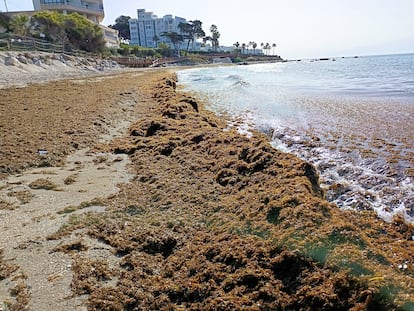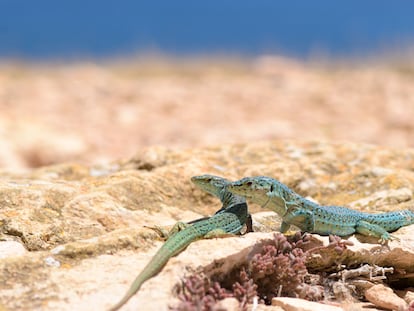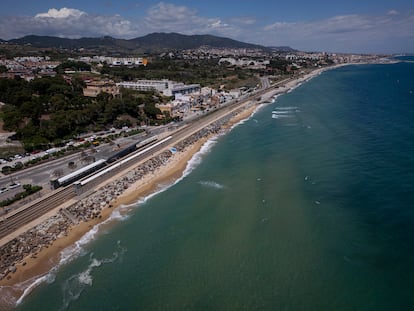The unstoppable clone army of invasive Asian seaweed ravaging the Spanish coast
A single ‘Rugulopteryx okamurae’ can form up to 600 copies of itself, and its steady advance shows no signs of slowing, with devastating effects for local biodiversity

An army of Rugulopteryx okamurae, an invasive Asian algae detected in 2015 in the Spanish exclave city of Ceuta, is advancing relentlessly along the coast, producing clones by the thousands and devastating biodiversity. This species, native to the Asian Pacific coasts, was seen in 2016 in Tarifa and Algeciras, on the southern tip of the Spanish mainland, and by now “its presence has been detected in all coastal communities except for the Balearic Islands,” says María Altamirano, who teaches botany at the University of Málaga and serves as vice president of the Spanish Society of Phycology, which studies algae.
Their advance shows no signs of slowing, driven by their adaptive and reproductive capacity. A single individual is capable of forming up to 600 new ones, and in posidonia meadows, the scientist’s team has estimated that there may be between 1,000 and 3,000 per square meter. And although they don’t wipe out the posidonia (also known as Neptune’s grass), at least not in the short term, they do wipe out the entire rich community associated with these habitats. “It’s as if a forest were left with only the trees,” explains the biologist.
The species survives through clonal mechanisms; sexual reproduction has not been observed. “The plants grow hundreds of tiny miniature algae on top of themselves, which break off and form new algae, like little people, and so on in asexual cycles that occur six times a year,” says Altamirano. In its native range, however, a new individual takes two years to form.
“There isn’t enough seabed to support such a large load of algae,” warns Altamirano. This problem leads them to believe that a large portion of the newly emerging individuals fail to attach to the seabed and form the huge amounts of biomass — known as arribazones — that end up on the beach and cause a significant socioeconomic impact. In the town of Tarifa alone, a popular destination for surfers and one of the most affected areas, the Andalusian regional government estimates that the cost of algae removal and the reduction of fishing catches amounts to $3 million annually. In this southern region of Spain, the algae has been detected from Punta Negra (Almería) in the east to Puerto Sherry (Málaga) in the west.
“Last year was horrible. We removed 12,500 tons of seaweed, because everything that comes out of the sea is considered solid urban waste, and cleanup is the city’s responsibility,” confirms Ignacio Trujillo, coordinator of Tarifa’s Tourism and Cultural Development Department. Another problem is that they don’t know when the algae will be washed up on the beach, and its amount can’t be controlled, “so we can’t make a forecast.”
Adding to this is the impact on the local fishing industry. “It’s amazing to see how they pull out their nets; they often have to break them,” Trujillo points out. “In 2015, our colleagues who worked with trammel nets and bottom-line fishing noticed a new algae, but no one from the government paid any attention,” explains Manuel Suárez, a fisherman, shipowner, and president of the Tarifa Fishermen’s Association. He adds that authorities didn’t start to worry until it affected tourism and the hospitality industry. “But by then it had already gotten out of hand.”
To continue fishing, they now use computer applications that locate spots with “less wind, less current, and therefore less algae.” But even so, their fishing days have been reduced. “This is a bomb, an environmental disaster worse than the Prestige [an oil tanker spill in 2002]. We’re fishing less because the algae suffocates the species and they move to other areas,” he explains. The only thing keeping them going is the tuna season, because they catch them on the surface where there is no seaweed, which is why they’re asking for a larger quota. “But the seabed is covered by football fields’ worth of algae, and the reefs and rocks are also covered and cannot be seen.”
Among the negative effects, the Andalusian regional government’s Department of Sustainability and Environment points out that it affects demersal species, those that feed on or near the bottom such as turbon, monkfish and sole, and “drastically” alters the habitat due to the amount of suspended algae that reduces water transparency.
This is the fourth time an invasive algae has arrived in the area of the Strait of Gibraltar. “There were three other virulent invasions, which severely affected the system and likely paved the way for Rugulopteryx,” Altamirano explains. This will continue to happen, she adds, “as long as we continue to receive large merchant ships arriving directly from Asia in the Strait and ballast water [the water pumped into a ship’s tanks to maintain its buoyancy and stability] is not adequately controlled, as required.”
The International Maritime Organization’s BWM Convention requires that this water be exchanged in the open sea, 200 nautical miles from the coast and at a depth of at least 200 meters. This ensures fewer organisms survive and prevents the introduction of new exotic species.
Ballast water in maritime traffic
Hypotheses suggest that the algae arrived due to large-scale maritime traffic bound for ports along the Strait. Its secondary dispersal has been caused by ocean currents and the movements of smaller vessels such as ferries, fishing boats and recreational boats, among other causes, according to the Andalusian regional government’s Department of Sustainability and Environment.
After 10 years, the Asian seaweed has reached parts of northern Spain like Galicia, Cantabria, Asturias, and even the Canary Islands off the western coast of Africa, as scientific predictive models indicated in 2019. And these are the known places, because the Moroccan coast is also invaded and its fishing sector is severely impacted, “but nothing is known about those areas.” The eastern limit of its distribution is in the Adriatic Sea between Italy and the Balkans, and on the northern African coast it is likely that it has gained a foothold in Algeria, Tunisia, and maybe even Libya, warns Altamirano.
In Spain’s northeastern region of Catalonia, meanwhile, the species was detected last year in low abundance. “We were fortunate to find them in an early stage,” says María García, a biologist at the Blanes Center for Advanced Studies (CEAB-CSIC) and responsible for monitoring invasive algae on the Catalan coast. Last week, they began sweeping the northern part of Cape Creus. “They’ve expanded a little, but not with the same progression as in the Strait, the Canary Islands or Galicia.” This doesn’t mean they won’t be abundant next year, because in other places like Portugal and Palermo, it took Rugulopteryx okamurae one or two years to make dramatic increases. They were also found in the area of the port of Barcelona, both in the commercial and Olympic ports, and along the Costa Brava.
Eradicating the species is an impossible task in a territory as vast as the ocean, and they could be anywhere. “This is just the tip of the iceberg; it’s the authorities that need to make the effort, but until the beaches are rotten with algae, they don’t do anything, and sometimes not even in those cases,” says Altamirano.
The Andalusian Department of Sustainability and Environment has just authorized a scientific project to study the agricultural use of algae as a fertilizer and sustainable agricultural biostimulant, with a view to using the seaweed that washes up on the coast. This initiative is part of a management plan that is currently being finalized.
Sign up for our weekly newsletter to get more English-language news coverage from EL PAÍS USA Edition
Tu suscripción se está usando en otro dispositivo
¿Quieres añadir otro usuario a tu suscripción?
Si continúas leyendo en este dispositivo, no se podrá leer en el otro.
FlechaTu suscripción se está usando en otro dispositivo y solo puedes acceder a EL PAÍS desde un dispositivo a la vez.
Si quieres compartir tu cuenta, cambia tu suscripción a la modalidad Premium, así podrás añadir otro usuario. Cada uno accederá con su propia cuenta de email, lo que os permitirá personalizar vuestra experiencia en EL PAÍS.
¿Tienes una suscripción de empresa? Accede aquí para contratar más cuentas.
En el caso de no saber quién está usando tu cuenta, te recomendamos cambiar tu contraseña aquí.
Si decides continuar compartiendo tu cuenta, este mensaje se mostrará en tu dispositivo y en el de la otra persona que está usando tu cuenta de forma indefinida, afectando a tu experiencia de lectura. Puedes consultar aquí los términos y condiciones de la suscripción digital.
More information
Archived In
Últimas noticias
Most viewed
- Sinaloa Cartel war is taking its toll on Los Chapitos
- Reinhard Genzel, Nobel laureate in physics: ‘One-minute videos will never give you the truth’
- Oona Chaplin: ‘I told James Cameron that I was living in a treehouse and starting a permaculture project with a friend’
- Why the price of coffee has skyrocketed: from Brazilian plantations to specialty coffee houses
- David King, chemist: ‘There are scientists studying how to cool the planet; nobody should stop these experiments from happening’











































